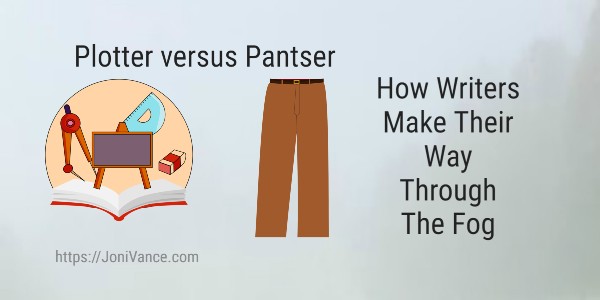
Plotters and Pantsers
First, let me define the terms so we’re on the same page.
— Plotter: A writer who plans, plots, or outlines the book before writing it. Also known as a planner or outliner.
— Pantser: A writer with an idea who starts writing, letting the story unfold as the words flow on the page. Also known as a writer who “flies by the seat of her pants”, a pantster, or an organic writer.
These are the two ends of the writing spectrum, but most writers are a hybrid.
Where do I fit?
I’m more of a plotter. I brainstorm the story in my head. I ask myself, “What if?”, “Who would be in the story?”, “What’s next?”, and “How does the character act and interact and change with the next event?”
I jot down bullet points of the idea until it falls apart, falls flat, or grabs my attention so compellingly that I can’t let it go.
If it falls apart or falls flat, I go back to the last, most interesting part of the idea and brainstorm a different path until the story and characters are so entrancing I can’t get away from them.
After all, if the story isn’t interesting to me, it probably won’t be to the reader, either.
Then I write down the main points and how the character develops, including the best ending I can think of at this stage.
What happens then?
— I create more intricate details about the events and characters. Snippets of dialogue dance in my head.
— When I sit down to write, the scenes I’ve brainstormed replay in my head like a movie. Dialogue comes easiest for me, so I write that first. At this point, I tell the emotions and actions. I may write a few details about where the characters are physically, but only to keep the “world” straight in my head.
— Then I identify gaps and other scenes necessary to get the characters from each main plot point to the next. I add those to the outline.
— Before I refine each scene, I specify author goal, character goal, the obstacles that block the character, and a potential scene-ending hook that makes it impossible for the reader to put the book down.
— As I write a rough draft, I “pants” to expand each scene. And I change whatever I want if more interesting ideas arise.
— Then I add layers to show character emotions, actions, and any of the five senses that enrich the scene.
The aim is that dialogue, actions, narrative, and description “show” to evoke emotion or “tell” to quickly advance the story.
How long does it take to brainstorm and plan and write and edit and refine?
No deadline? More time than I, or anyone who wants to read it, would like.
Deadline? Write the best-crafted book you can in the time you have.
A Pantser’s Path
Many of my friends lean more toward the pantser end of the spectrum.
Every writer’s process is different, but from what I understand, a pantser has a kernel of an idea, and they sit and write out the story. They let the ideas flow on the pages. Then they look at it and filter out what they don’t want and write more of what they do.
My detailed, analyze everything brain can’t explain it better than that. I’m certain a pantser could.
Two methods, one primary goal
Writers may have different secondary goals for their stories. Some may want to inform, others entertain, and still others may want to inspire.
But whatever the method or wherever a writer falls on the spectrum, I believe every writer shares at least one common goal:
Write a “can’t put down” story that stays with the reader long after the last page is read.
What do you think about how writers create their stories? And in life, are you more a planner or pantser?
Writers Are Plotters or Pantsers — In life, are you more a planner or pantser? Share on XJoni Vance is an award-winning author of fiction, essay, and poetry. She loves mystery, history, and how God reveals Himself every day.
May God reveal the mystery of His love in your life story.

Thanks for this Joni. I am a plotter when I write. And I am a planner in almost every area of life. For writing and life, I don’t have to have every detail written down, but I have to have the bones with a little room to stray from time to time. But, I always need to know where I need to return to to keep things on the path I’ve selected.
Thanks, Tim. I’m pretty much the same way. 🙂 I appreciate you reading and sharing.
I love to hear how other writers create their stories. I find it amazing—how it all comes together into a book that readers can’t put down. I probably lean toward being a pantser when I write.
I think we all brainstorm everything and decide what we want to keep. The process is just different. 🙂 Would love to see a blog from you about how you create your stories!